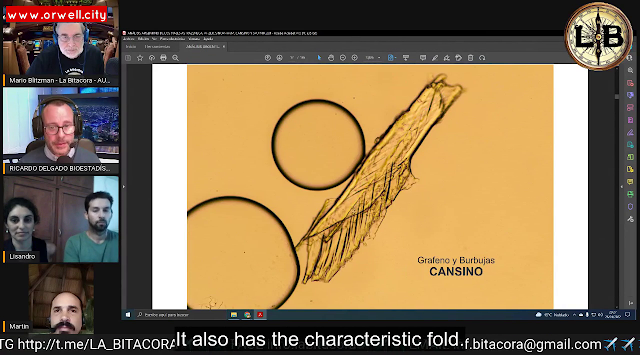La Quinta Columna comments on the vaccine vials analysis report carried out in Argentina
January 28, 2022La Quinta Columna was present in the Australian channel "La Bitácora" with the team of researchers in charge of the analysis of vaccination vials carried out in Argentina and commented on the finding of graphene oxide and microtechnology in them.
The analyzed vials were from Cansino, Pfizer, Sinopharm, AstraZeneca, and Sputnik.
Below, Orwell City brings the key excerpt into English.
Ricardo Delgado: Here's the introduction. The vaccines that are going to be part of the analysis are Cansino, Pfizer, AstraZeneca, Sinopharm, and Sputnik. And here you're going to compare them, let's say, with the pattern of reduced graphene oxide taken from Dr. Campra's first preliminary report, back on June 28th of the last year 2021. These famous graphene ribbons have a characteristic fold. This is the pattern to compare. Taken from this vial. There are different images. Remember that Dr. Campra himself talked about it as if it were a toilet paper directly thrown on the bottom of a swimming pool. It has those characteristic edges, those folds.
The applied analysis method. About the microscope. "We worked with a Nikon Eclipse 50i microscope." "And the magnifications used for the observation were from 100x to 1000x. We have observed samples of a fresh drop directly, using slides on some occasions."
Let's start with Cansino, ok? And let's comment on the images if you want. I feel troubled to do the introduction when the work is yours.
Anabela Femia: Yes. No problem. I don't know, Martín, if you want to comment on what we saw.
Dr. Martín Monteverde: No. Just that if Mario doesn't have much program time available... If you want, go through the images quickly.
Ricardo Delgado: Yes, fine. Well, there's a series of a typology of objects found in the Cansino's vaccine, which resemble graphene because of the appearance they have. Microbubbles. This is a constant in all the vaccines analyzed. More of them are seen here.
This is also a considerable piece of graphene. This, let's say, is a graphene micro-sheet. It also has the characteristic fold. The borders are... Here's another one with a certain filter. Clearer. You can see it here too.
You have to remember something very important. And that is that none of this should be seen under the optical microscope. Remember that they were talking about lipid nanoparticles. So, everything would be observable under the electron microscope. Moreover, homogeneously. So, this shouldn't be seen. Yes?
Anabela Femia: Yes, well... Something we discussed yesterday...
Ricardo Delgado: Yes?
Anabela Femia: Sorry... Something we were saying yesterday is that we had observed as a kind of control, a suspension of 100 nm particles to see if they would show up. But no. No, no, no. You don't see that size. So everything that we were observing is much larger than that size and shouldn't be present. Right.
Ricardo Delgado: 100... Sorry. 100 nm would be 0.1 microns. At least, it has to be a couple of tens of microns to show up under the light microscope.
Mario Blitzman: Yes. I wanted to comment, also, that from the beginning there should be none of these specimens. And that you don't know what's inside.. Let's get down to basics. It's impossible. Even here in Australia, they tell you that if you have any doubts you consult with your doctor. Now, what can the doctor know if, for example, I tell him that I found a little pill in my dresser drawer and I'm going to take it? He's going to tell me, "I'm sure there's nothing wrong." In other words, if he doesn't know what's inside, he can't tell me if something is going to happen or not. It's totally... I don't know what to call it. Antibiotic, anti-medicine, anti-science?
Ricardo Delgado: And they shouldn't be recommending it. Nor pushing and coercing, and practically threatening people to get inoculated with something that they haven't even looked at the light microscope.
Well, now let's look at images of the Pfizer vaccine. Here clearly appears an artificial pattern reminiscent of the famous microcircuits. Whether they're micro-routers, micro-antennas, also found in other previous analyses. Microbubbles. I think they were also shown by Carrie Madej on the Stew Peters' show. This one is very characteristic. It's more carbonaceous in appearance, right? This is a consequence of several layers being overlapping. Graphene tends to appear, let's say, more carbonaceous or more blackish depending on that number of layers or more translucent. More microbubbles. More. This is a very good photograph. Here you see a very characteristic shape. We've seen this type of photograph a lot.
And here...
You can also find... If you search scientific publications for other applications of graphene or graphene oxide, you find images very similar to these ones. It isn't something that only appears in Dr. Campra's report. It seemed to us that those pictures that they had published at the time were the most meaningful ones to compare. But there's a lot of evidence that this has a strong similarity to the graphene oxide pattern.
Lisandro Laferriere: And another thing that we also highlighted yesterday, is that this was seen in all of the brands that were analyzed. You can't say this is batch contamination or things like that because it was seen in all the vials that we analyzed.
Ricardo Delgado: Indeed.
Lisandro Laferriere: Right.
Ricardo Delgado: If it's contamination, it would mean that all vials been contaminated with the same element, right? In Spain, in France, in Germany, in Chile, and Argentina.
Lisandro Laferriere: Exactly.
Very characteristic and very reminiscent of the pattern, isn't it? This too. This also appeared in a Pfizer vial that we looked at here at home. Here appears graphene, and here below a possible microcircuit. Microbubbles.
Mario Blitzman: While you're showing the images, can somebody explain to me a little bit what do you think about these circuits in all this? What would they do?
Ricardo Delgado: Well...
Mario Blitzman: Let's imagine a little bit.
Ricardo Delgado: I can comment, and then Dr. Martín Monteverde and them can go deeper. Based on what we have investigated in the scientific literature, this graphene introduced in the vials would serve to transpose or convert the gigahertz frequency of telephone antennas into terahertz. And it turns out that the terahertz band is where all the micro-antennas, micro-arrays, and all that micro-circuitry that we've seen works. Sure, but we should make pretty clear the side effect of introducing graphene into the body. Because in our opinion, it's an acute radiation syndrome, because it increases the toxicity of the material in a radiation-dependent way. And that favors the generation of the famous cytokine storm, as a consequence of the fact that this graphene releases a multitude of free radicals in the organism. The immune system collapses, and the cytokine storm is triggered. Graphene is eliminated by the lung. When lungs are irradiated, bilateral pneumonia is developed. And also, it's a toxicant that's going to inflame pretty much everything. Therefore, you have systemic inflammation, cytokine storm, and bilateral pneumonia. In other words, what they have called COVID-19. If we originally talked about there being no sequenced virus, because there's a lot of doubt that they have sequenced it, well, here you have the answer. So, we aren't talking about a pandemic. We're talking about a conscious and premeditated genocide.
Mario Blitzman: Martín, there's something that I wanted to ask you and that I found very interesting at the conference you gave yesterday. What you showed —and I thought it was very transparent and open—, is that you have the samples and invite anyone from the government to make these analyses, isn't that right?
Dr. Martín Monteverde: Yes, although I see it difficult. But...
Mario Blitzman: Yes...
Dr. Martín Monteverde: But we do have material left. We have enough material. Practically, half a vial of each one of them. Yes, if anyone would like to verify this, can take these same samples and analyze them. Or new samples as we get them. Yes. What would have to happen here is that more researchers would have access to vials, which isn't easy in Argentina. It took us six months to get the vials. And then analyze them with a microscope, which is easy. And for some reason the Faculty of Medicine, CONICET, ANMAT itself, for some reason all the health agencies and the educational and university agencies in Argentina seem to have in order not to examine the vials.
Mario Blitzman: Well, that happens all over the world. It happens in Australia, doesn't it? And I don't know if you're aware, but Australia is one of the most severe countries, let's say, if you don't following the rules. Not following the rules here is quite complicated. It's a very complex issue. Doctors have been removed for talking about this or saying something about Ivermectin. They're immediately stripped of their title, for example. So there's an atrocious panic.
You see, the person who wrote to me is scared because knows how it works. I have talked with doctors in Australia. You know that the first study, for example, with Ivermectin, was done by Dr. Thomas Borodin, who's a doctor in Sydney. He did an in vitro study. And I have communicated with him to invite him to the radio, and he said no, he cannot come to the radio. And I have talked with another person as well. I have been contacted from Argentina, with Dr. Carballo, who had obvious medical knowledge when you talk to him. And when I talked to him, he told me things quite... He told me that he couldn't come to the radio. And when he told me that... That's when the word "corruption" came into that conversation, right? That's what this doctor said.
In other words, everywhere is like this, and it isn't only Argentina. This isn't to make anyone feel better. On the contrary. Unfortunately, it's to feel worse because it isn't only Argentina. It's a worldwide situation. You see this happening in Canada and any country in the world. Sorry, let's continue with the presentation.
Ricardo Delgado: Now that you have commented on that, Mario, I've been corresponding with a Ph.D. in Chemistry from a Spanish university where several researchers had independently started to analyze vaccines. They had subjected samples to certain techniques, including micro-Raman, and had found reduced graphene oxide as well. However, a few days ago, the order was to distort the work and send each of the collaborators to different parts of Spain to continue with other tasks. That has been the order and the slogan from the university. After a telephone call, probably from higher institutions.
Mario Blitzman: It's clear that the solution... I think the solution in all this is that people must continue, as I say, educating, informing the population so that the population demand that the officials do what they have to do. And that these officials always remember that the salary and the position they have was given by the people to do certain types of things and not to do whatever they want, freely and with impunity, right?
Ricardo Delgado: Well, the conclusions. The results. "We have confirmed the presence of graphene sheets, graphene ribbons, graphene microbubbles, graphene agglutinates or agglomerates, and/or graphene derivatives in all the samples. We also noted the presence of artificial rectangular and square structures. There were some very clear. Some compatible with microcircuits in all vials." And the attached photograph.
Full report:
Source: DocDroid
If you like my articles and the videos you find here and, if you can and feel like it, you can make a small donation. Your support is always more than appreciated.
Follow Orwell City on Telegram. Thank you for reading!
—Orwellito.




























0 comments